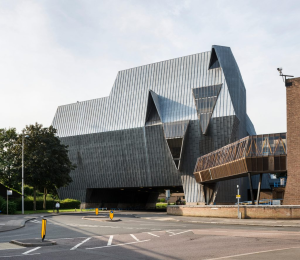 The Twentieth Century Society (C20) is launching a new nationwide campaign to celebrate the architecture of the leisure centre and to protect the most historic examples.
The Twentieth Century Society (C20) is launching a new nationwide campaign to celebrate the architecture of the leisure centre and to protect the most historic examples.
image: for illustration only – Coventry Sports Centre, Historic England
… Is there any other building-type that’s as wildly varied and downright eccentric?…
C20 writes:
Leisure centres are places of community identity and an intensely evocative part of our shared social heritage: flumes, verrucas, palm trees, the smell of chlorine, the sound of laughter – this is the backdrop to childhood experiences and families at play. Yet they’re also some of the most architecturally innovative structures of the late twentieth century, combining environmentally controlled environments with soaring engineering and playful pop imagery. Is there any other building-type that’s as wildly varied and downright eccentric? Space-age geodesic domes, diamond glazed pyramids, castellated forts, brutalist elephants and Moorish postmodern palaces are just a few of the highlights of this idiosyncratic genre.
Some key examples remain from the 1970s boom in publically-funded municipal leisure centres, others are playful evolutions on the theme from more recent decades, while the exotic continental import of Center Parcs signalled a later shift to a packaged holiday experience. Most were designed around a free-form tropical pool, others focussed on hard courts and recreational sports. All are underappreciated and unexamined buildings in need of our support.
‘All pools at risk’.
The decimation of local authority budgets over the last decade has already forced many centres to close, with the challenges of the past couple of years only heightening the threat they now face. The Covid pandemic, global chlorine shortages and the soaring energy costs have meant that, in the words of Swim England’s chief executive, “Every pool is now at risk”. A report commissioned by the national governing body in September 2021 – prior to the current energy crisis – estimated that 40% of public pools in the country (1,800+ sites) could be forced to close by 2030. Even Swindon Oasis, added to the national list less than a year ago, has faced threats of a de-listing attempt by developers and the local Conservative administration, unwilling to invest in re-opening the centre.
Thirty years after the Societies ‘Farewell my Lido’ campaign started the movement to save our vanishing outdoor bathing heritage, we hope this sequel will stir the same appreciation for these subtropical places of pleasure and play. The time to act and preserve the most notable leisure centres is now.
FaulknerBrowns Architects at the fore
From Cornwall to the Shetland Islands, we’ve scoured the length and breadth of the UK to identify the most outstanding examples of leisure centres, submitting ten to be considered for listing to Historic England, Historic Environment Scotland and Cadw (Wales).
Five of the ten cases put forward are by FaulknerBrowns Architects, the Newcastle-based practice who led the way in leisure centre development from the 60s to the 90s. While their ground-breaking Bletchley leisure centre – a huge diamond plastic and steel pyramid, similar to I.M.Pei’s celebrated addition at the Louvre – was sadly demolished in 2010, their surviving projects effectively plot the design evolution from community sports to Leisure Centres.
From the Walker Activity Dome (1965) near Newcastle, a facility geared toward the recreational sportsperson, with hard courts beneath a timber framed dome, to the Concordia Leisure Centre in Cramlington (1973); a plain, boxy brick, top-lit structure, with provision for both leisure and competitive swimming, with a sports hall that doubled up for social events and concerts. By the time of their later pool projects in Perth (1988) and Doncaster (1989), the emphasis was firmly on entertainment and eye-catching design, the latter featuring postmodern cupolas, pastel banded stonework, decorative steelwork with shades of the Alhambra and a glazed rotunda dubbed a ‘mock Pantheon dedicated to the gods of leisure’.
